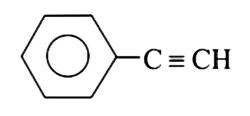Which one of the following compounds does not decolourise an acidified aqueous solution of KMnO4
Suluphur dioxide
Ferric chloride
H2O2
FeSO4
The correct Answer is:2
To determine which compound does not decolorize an acidified aqueous solution of KMnO4, we need to analyze the oxidation states of the compounds provided and their ability to reduce KMnO4 (where Mn is in the +7 oxidation state).
1. Understanding KMnO4:
- KMnO4 contains manganese in the +7 oxidation state. When it is reduced, it changes color from purple to colorless or light pink, indicating a reduction in the oxidation state of manganese.
2. Analyzing the Compounds:
- We need to identify which of the given compounds can reduce KMnO4 and which cannot.
3. Compound 1: SO2 (Sulfur Dioxide):
- SO2 can act as a reducing agent. It can reduce KMnO4 (Mn +7) to Mn +2, thus it will decolorize the solution.
4. Compound 2: FeCl3 (Ferric Chloride):
- In FeCl3, iron is in the +3 oxidation state. Since +3 is the maximum oxidation state for iron, it cannot be oxidized further. Therefore, it cannot reduce KMnO4, which means it will not decolorize the solution.
5. Compound 3: H2O2 (Hydrogen Peroxide):
- H2O2 can act as both an oxidizing and reducing agent. It can reduce KMnO4, thus it will decolorize the solution.
6. Compound 4: FeSO4 (Ferrous Sulfate):
- In FeSO4, iron is in the +2 oxidation state. Fe2+ can be oxidized to Fe3+, allowing it to reduce KMnO4, thereby decolorizing the solution.
Conclusion:
Among the compounds analyzed, FeCl3 (Ferric Chloride) does not decolorize an acidified aqueous solution of KMnO4 because it cannot be oxidized further and thus cannot reduce Mn from +7 to a lower oxidation state.
Final Answer:
FeCl3 (Ferric Chloride) does not decolorize an acidified aqueous solution of KMnO4.
---
- KMnO4 contains manganese in the +7 oxidation state. When it is reduced, it changes color from purple to colorless or light pink, indicating a reduction in the oxidation state of manganese.
- We need to identify which of the given compounds can reduce KMnO4 and which cannot.
3. Compound 1: SO2 (Sulfur Dioxide):
- SO2 can act as a reducing agent. It can reduce KMnO4 (Mn +7) to Mn +2, thus it will decolorize the solution.
- In FeCl3, iron is in the +3 oxidation state. Since +3 is the maximum oxidation state for iron, it cannot be oxidized further. Therefore, it cannot reduce KMnO4, which means it will not decolorize the solution.
- H2O2 can act as both an oxidizing and reducing agent. It can reduce KMnO4, thus it will decolorize the solution.
- In FeSO4, iron is in the +2 oxidation state. Fe2+ can be oxidized to Fe3+, allowing it to reduce KMnO4, thereby decolorizing the solution.
Among the compounds analyzed, FeCl3 (Ferric Chloride) does not decolorize an acidified aqueous solution of KMnO4 because it cannot be oxidized further and thus cannot reduce Mn from +7 to a lower oxidation state.
FeCl3 (Ferric Chloride) does not decolorize an acidified aqueous solution of KMnO4.
Topper's Solved these Questions
Similar Questions
Knowledge Check
Which of the following compound does not decolourise bromine-water solution ?
A B
B C
C D
D
Which do not decolourise KMnO4 in aqueous solution?
AC2O2−4BHSO−3CCO−3DSO−3Which one of the following organic compounds decolourizes an alkaline KMnO4 solution
ACS2BC3H6CC3H8DCH3OH
Among the following compounds which one cannot decolourise alkaline KMnO4 solution?
View SolutionWhich of the following will not decolourise acidified KMnO4 ?
View SolutionWhich of the following does not react with aqueous KMnO4 ?
View SolutionWhich of the following does not decolourise bromine solution in carbon disulphide
View SolutionWhich one of the following is not oxidized by acidified KMnO4 ?
View Solution
